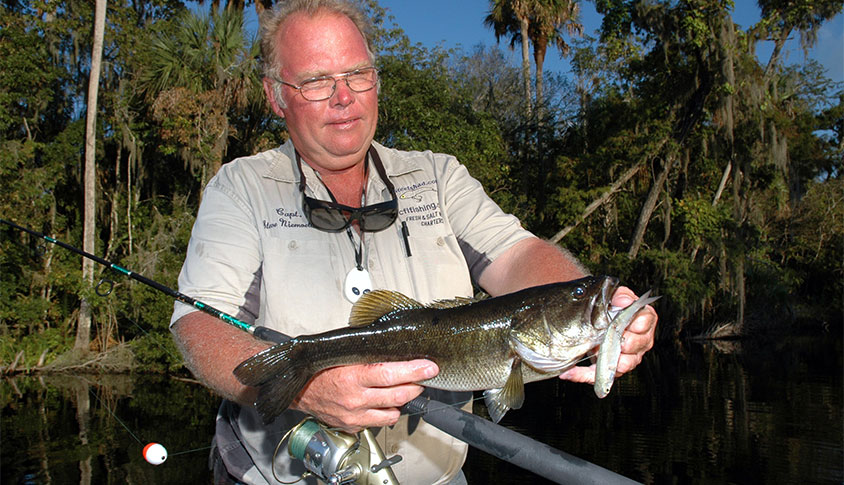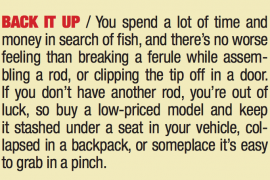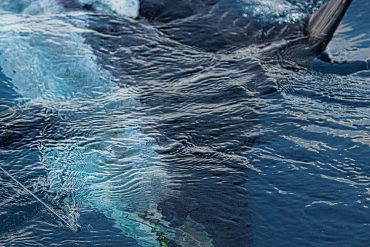Mullet Offer Bass Anglers a Low Cost Alternative
Moments after the float landed next to a log protruding from matted vegetation, it disappeared into the dark tannic water almost as if someone threw a rock instead of a bobber. “That didn’t take long,” exclaimed Steve Niemoeller with CFL Fishing Charter Service of Deland, FL, as he set the hook on a fat 6-pound largemouth. “Usually, I fish with wild river shiners. I have never fished for bass with mullet before, but I had some left over from a saltwater trip and decided to give them a try.”

Many anglers tempt bass with wild river shiners. Native to most Florida waters, the golden-hued baitfish provide significant forage and probably offer the best temptation for big bucketmouths. However, wild shiners are fragile and cost big bucks, when bait shops can keep them in stock. Mullet are hardy and cost nothing—if anglers know how to throw a cast net.
In brackish water, largemouth bass and redfish frequently feed upon the same forage so what tempts a redfish would certainly tempt a big, hungry bass.
Common forage for numerous species, mullet gather in huge schools. In a productive area, anglers can catch a boatload of free bait with just a few throws of a net. Tough as nails, mullet last longer than shiners and remain more active on the hook. All along coastal Florida, anglers use live mullet four-to-eight inches long to catch redfish, tarpon, snook and other salty species. In brackish water, largemouth bass and redfish frequently feed upon the same forage so what tempts a redfish would certainly tempt a big, hungry bass.
In Florida, anglers usually see two common mullet species—striped and silver. Striped mullet, also called black mullet, thrive around the state. As the name implies, striped mullet exhibit several horizontal black lines and look similar to a miniature striped bass. Striped mullet can grow longer than 19 inches and may weigh several pounds.
Silver mullet look very similar to striped mullet, but lack horizontal stripes. Silver mullet don’t grow quite as large and typically weigh less than one pound. Both species live in brackish water, but silver mullet prefer greater salinity levels. Rich in oil and protein, both species make excellent forage for many popular game fish, including largemouth bass.
“Largemouth are opportunistic feeders,” advised Brandon Thompson, a freshwater fisheries biologist for the Florida Fish & Wildlife Conservation Commission in Eustis. “There’s no reason bass wouldn’t eat mullet if they can catch them, especially in bodies of water where they are accustomed to seeing them.”
Niemoeller recommends fishing mul-let two to three feet under a float on a 2/0 or 3/0 weedless hook, the same way you would fish a shiner. Select 3- to 5-inch finger mullet, hook through the lips or under the dorsal fin and cast them next to prime cover, such as matted weeds or fallen logs. Focus on areas with adjacent access to deeper water and shallow flats. For deeper presentations, you can freeline live mullet with or without added weight. Fish a couple baits shallow and a couple deep. Then, wait for the bait to attract attention but don’t react too quickly when you suspect a strike. A bass might move a baitfish around in its mouth a few times to re-position it before swallowing the unfortunate victim head first, so don’t attempt to drive the hook home until the fish swims away from the boat.
Although giant largemouth can easily inhale huge prey, bass can more easily swallow a streamlined mullet than a much wider shiner of similar length. “Mullet are slimmer than shiners so bass actually take them quicker, hence the easy-to-eat offerings frequently tempt more bass, although shiners may entice bigger fish,” Niemoeller added.
“The first time I used mullet for bass, I fished an area where I often fish shiners. The bass jumped on the mullet the instant it hit the water. Sometimes, shiners sit in the exact same spot for a long time before a bass will even look at it. It is quite possible mullet entice more bass than shiners because so few anglers actually fish them in freshwater. Bass can grow accustomed to certain baits,” Thompson explained. The biologist went on to say, “If anglers throw enough spinnerbaits or crankbaits in a particular lake, bass get acclimated to those baits and start avoiding them. When someone comes up with a new lure type, it works great for a while because bass haven’t seen it before. The same may be happening with shiners and mullet. Whatever the case; they work great!”
Using mullet clearly works best where largemouth naturally encounter them, such as brackish river deltas. In addition, mullet can enter any freshwater system that connects to saltwater, such as Lake Okeechobee. Other prime locations include the St. Johns, Suwannee and Apalachicola rivers, but any river that flows into saltwater could make a great place to try these readily available offerings. The range of mullet and bass overlap throughout much of Florida. Where they do overlap, bass eat mullet. For the best results, anglers should capture the mullet on the system they plan to fish.
When bass refuse plastic, metal or wooden temptations, entice them with fresh meat. A succulent, struggling mullet might prove too tempting for even the largest lunker.
Annual Run Triggers Frenzy:
In the fall, sportsmen all across Florida eagerly await the mullet run. Large schools of striped mullet venturing offshore to spawn kick off a major feeding frenzy. Where baitfish gather, hungry predators hunt—and just about every finned, furred or feathered predator eats mullet.
“In Florida, striped mullet spawn from October to January on both coasts,” explained Dr. Behzad Mahmoudi, a marine biologist with the Florida Fish and Wildlife Research Institute in St. Petersburg. “In the Panhandle and the St. Johns River in northern Florida, the mullet run usually peaks from late October to late November. In southern Florida, the peak is from late November through early January. During spawning season, mullet move offshore with the passage of cold fronts.”
When the barometric pressure and air temperatures drop, mullet make a run for the sea, frequently heading offshore in bad weather to fool predators. The tactic doesn’t usually work. When mullet make their move, sharks, tarpon, sailfish, king mackerel and just about anything else large enough to gulp them down follow the school and attack.
“Some predators changed their migratory habits to match that of the mullet,” Mahmoudi said. “Predators go where they find food. On the Gulf Coast, mullet swim 50 to 100 miles offshore. On the East Coast, the continental shelf is narrower and mullet may roam to the edge of the Gulf Stream. Mullet spend a month or two offshore. After spawning, mullet move back inshore, almost to the same area they left. It is like a salmon run in reverse.”
In the spring, another minor mullet run takes place when silver mullet spawn. Silver mullet may spawn 40 or more miles from shore, but typically don’t gather in such large schools as striped mullet.
A female mullet might produce seven million eggs. After the eggs hatch, young mullet remain offshore for a month or two until they reach an inch long. Then, they start making their way back to their home estuaries. At the estuary mouths, young fish might spend three or four months letting their bodies adjust to the lower salinity level before moving inland. After about a year, young mullet grow to about six inches long, making them the perfect size to tempt largemouth bass and other popular game fish.
Mullet Offer Bass Anglers a Low Cost Alternative
Moments after the float landed next to a log protruding from matted vegetation, it disappeared into the dark tannic water almost as if someone threw a rock instead of a bobber. “That didn’t take long,” exclaimed Steve Niemoeller with CFL Fishing Charter Service of Deland, FL, as he set the hook on a fat 6-pound largemouth. “Usually, I fish with wild river shiners. I have never fished for bass with mullet before, but I had some left over from a saltwater trip and decided to give them a try.”

Many anglers tempt bass with wild river shiners. Native to most Florida waters, the golden-hued baitfish provide significant forage and probably offer the best temptation for big bucketmouths. However, wild shiners are fragile and cost big bucks, when bait shops can keep them in stock. Mullet are hardy and cost nothing—if anglers know how to throw a cast net.
In brackish water, largemouth bass and redfish frequently feed upon the same forage so what tempts a redfish would certainly tempt a big, hungry bass.
Common forage for numerous species, mullet gather in huge schools. In a productive area, anglers can catch a boatload of free bait with just a few throws of a net. Tough as nails, mullet last longer than shiners and remain more active on the hook. All along coastal Florida, anglers use live mullet four-to-eight inches long to catch redfish, tarpon, snook and other salty species. In brackish water, largemouth bass and redfish…





